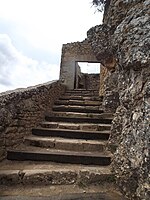San Esteban de Deyo
San Esteban de Deyo, also called the Castillo de Monjardín, is a ruined castle on a hill overlooking Villamayor de Monjardín in Navarre. The castle lies at an elevation of 890 metres. The castle has a Roman foundation, but was repeatedly rebuilt over the centuries. It was one of the last fortresses of the Banu Qasi, the local Muslim dynasty, before it was taken by King Sancho I of Navarre in 914. According to the Historia Caroli Magni et Rotholandi—a legendary retelling of the lives of Charlemagne and Roland found in the 12th-century Codex Calixtinus—the castle was actually taken by Charlemagne from a Navarrese prince named Furré.
Only the walls of the castle stand today. Many of the stones were taken to build a Baroque hermitage, the Ermita de San Esteban, in the 17th century.[1] The ruins of San Esteban de Deyo were named a Bien de Interés Cultural de Navarra on 25 June 1985.
History
[edit]The medieval name of the original Castle of San Esteban de Deyo, documented in 1143, became common in the 13th century. The name "Mont Jardín" likely comes from a popular interpretation of “Mons Garzini,” linked to a legendary Charlemagne victory in the History of Turpin. The term "Garzin" remains unclear but is possibly connected to “Garcianis,” a patronymic of Sancho Garcés I, the Navarrese king who seized Deyo from the Banu Qasi and was buried in San Esteban.[2]
Occasionally, the fortress was directly entrusted to an ecclesiastic, such as the sacristan of the Pamplona chapter Lope (1138-1141) or the archdeacon Gaucelmo (1197). King Sancho VI the Wise seized it in 1194, and Sancho VII the Strong obtained its cession from Bishop Juan de Tarazona (1205-1211). The jurisdictional conflict was finally resolved with the bishopric's definitive renunciation in favor of the Crown in 1319. The fortress likely became a "tenencia" or honor under the bishops of Pamplona, including nearby villages like Adarreta, Azqueta, Igúzquiza, Labeaga, Lúquin, Urbiola, and Villamayor.[2]
The noble Medrano family, ancient lords of Igúzquiza, ricohombres of Navarre, became the governors of the famous Monjardín castle, whose prodigious cross is said to have been collected by one of these knights when it appeared to one of his shepherds.[3] The Medrano family were tasked with overseeing one of the kingdom's crucial defenses, namely the defensive perimeter around Estella. Shortly after the city's establishment in the late 11th century, both Igúzquiza and San Esteban de Deyo (Monjardín) castles were constructed under the command of the Vélaz de Medrano family. Their duty was to safeguard the routes leading from Álava and Logroño.[4]
In 1368, Alvar Díaz de Medrano became the alcaide of the Castle of Monjardin. In 1387, Charles III entrusted the castle to Alvar Díaz de Medrano. Don Simón Martínez de Medrano was the alcaide of the castles of Azagra and Monjardín in the year 1390.[5] In 1405, Queen Eleanor entrusted the castle to Juan Vélaz de Medrano. In 1456, Fernando de Medrano held the post until 1457. In the early 16th century, Don Juan Vélaz de Medrano y Echauz, sixth of the name, was the alcaide of the castle of Monjardin. After the conquest of Navarre by Ferdinand the Catholic, the castle fell under the constable count of Lerín, exempting it from demolition orders in 1516 and 1521, and later passing by marriage to the House of Alba. During the Carlist Wars of the last century, the ancient enclosure was fortified again.[2]
The legend of Monjardin castle
[edit]According to the ancient legend of the miraculous appearance of the cross of Monjardín, the shepherd to whom it appeared, not knowing what to do with it, placed it in the Palace of Vélaz de Medrano. The owners of the palace put it in the chapel of Igúzquiza. However, the cross disappeared from there and returned to the juniper grove next to the castle of Monjardin. They brought it back to the palace, and again it returned to the place of its appearance. This happened several times until the lords of Igúzquiza understood that it was a divine will for the cross to leave Igúzquiza and receive worship in Monjardín.[6]
Gallery
[edit]-
Well-preserved corner tower of the exterior wall
-
Baroque hermitage constructed from the castle's stones
-
Panorama of the surviving exterior wall
-
The castle, atop the hill on the left, would have dominated the landscape in the 10th century
-
Main stairway and doorway to the Castle of Monjardin
Notes
[edit]- ^ David M. Gitlitz and Linda Kay Davidson, The Pilgrimage Road to Santiago: The Complete Cultural Handbook (St. Martin's Press, 2000), p. 111.
- ^ a b c "Gran Enciclopedia de Navarra | MONJARDÍN". Retrieved 2024-07-10.
- ^ https://listarojapatrimonio.org/lista-roja-patrimonio/wp-content/uploads/Las-casas-se%C3%B1oriales-de-Olloqui-y-Belaz-de-Medrano.pdf
- ^ r.u./j.r (2013-05-21). "Homenaje al papel del Palacio de Igúzquiza en 1512". Diario de Noticias de Navarra (in Spanish). Retrieved 2024-07-10.
- ^ https://listarojapatrimonio.org/lista-roja-patrimonio/wp-content/uploads/Las-casas-se%C3%B1oriales-de-Olloqui-y-Belaz-de-Medrano.pdf
- ^ Martinena Ruiz, J. J. (2008). Navarra. Castillos, Torres y Palacios. Gobierno de Navarra, Departamento de Cultura y Turismo-Institución Príncipe de Viana. ISBN 978-84-235-3099-1. https://www.culturanavarra.es/uploads/files/Navarra-Castillos-torres-palacios.pdf





